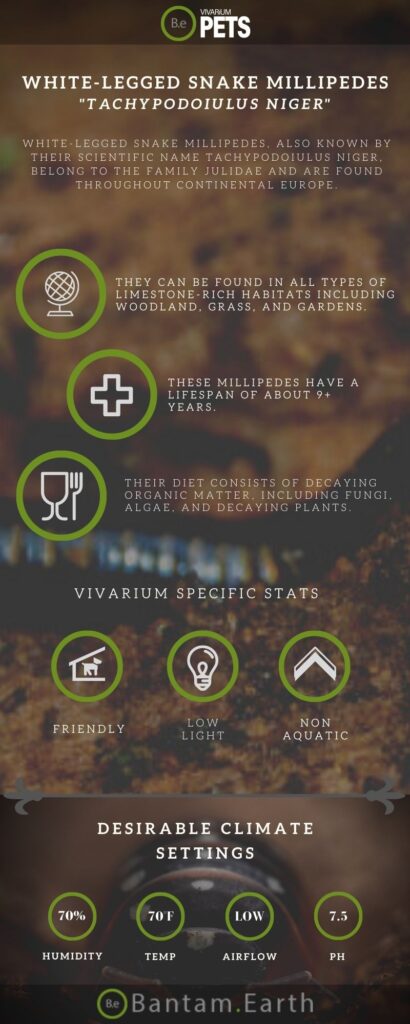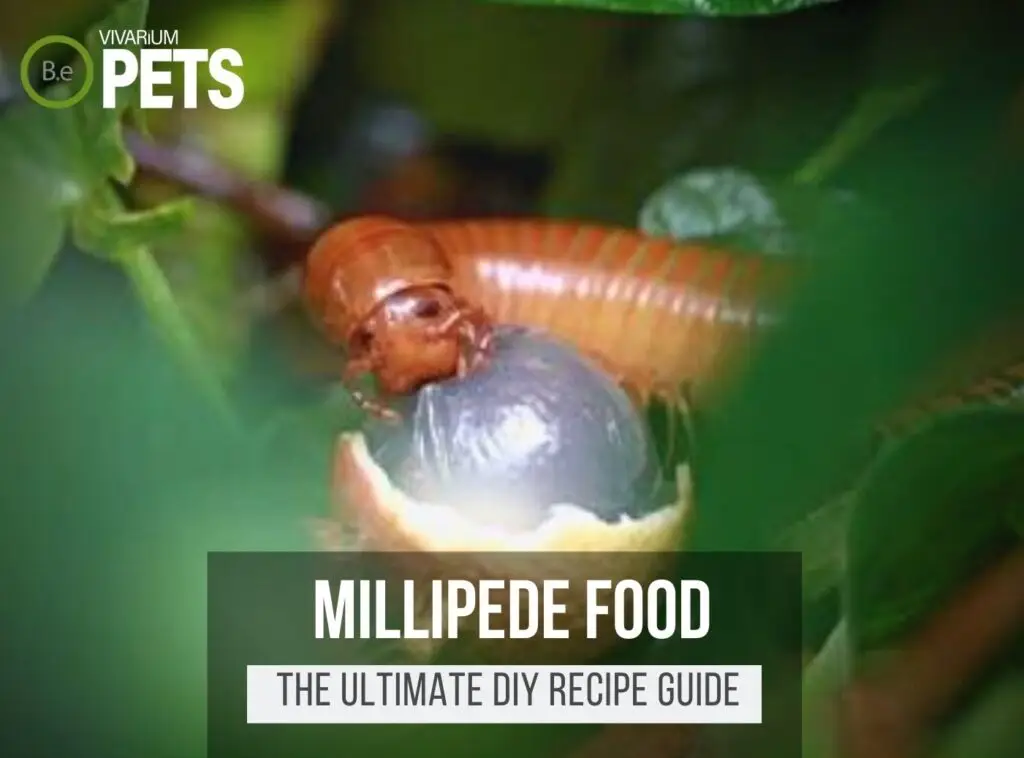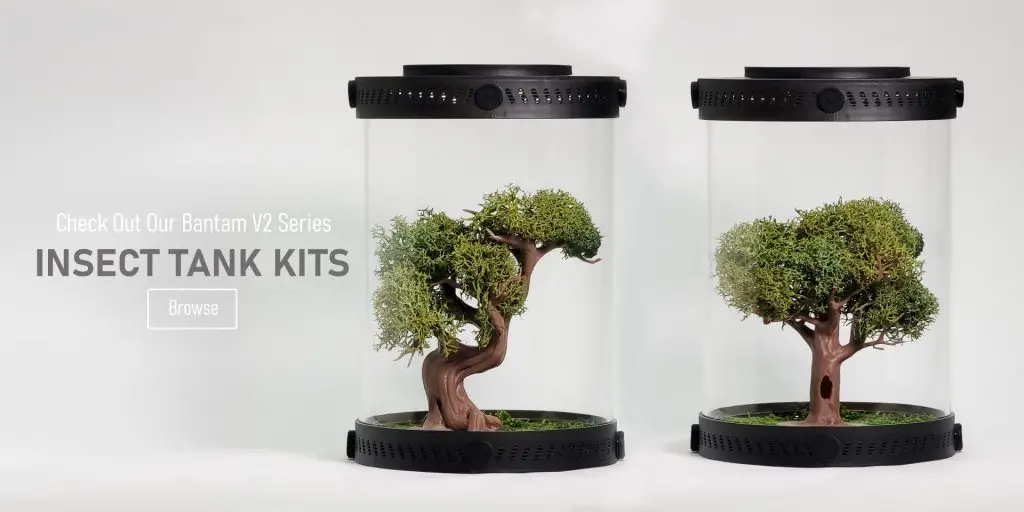Welcome to the White-legged Snake Millipede (Tachypodoiulus niger) Care Guide!
This species is often regarded as a beginner-friendly species of millipede and is found throughout much of continental Europe.
In this guide, we’ll cover everything you need to know to properly care for your small millipede pet.
This includes habitat requirements, feeding, handling tips, and common health issues.
So let’s get started!
Table Of Contents:
ToggleWhat Are White-legged Snake Millipedes?
White-legged Snake Millipedes, also known by their scientific name Tachypodoiulus niger, belong to the family Julidae and are found throughout continental Europe.
The common name of this species comes from the fact that they resemble snakes – they have white legs and move in a sinuous motion.
They are an excellent beginner-friendly species for anyone looking for a pet millipede.
Create an ideal habitat for your millipede with our Customizable Millipede Enclosure Kits, which include everything you need to get started.
What Do White-legged Snake Millipedes Look Like?
White-legged Snake Millipedes can reach up to 60mm in length and are a dark brown or black color.
They have a cylindrical body comprised of numerous segments, each featuring around 30 to 35 pairs of legs.
Tachypodoiulus niger also has white legs and a dark-colored head. In bright light, they will exhibit a beautiful iridescent green sheen.
White-legged Snake Millipedes have antennae that are twice as long as their head, used mostly for sensation and recognizing nearby food sources.
Additionally, their underside is covered with very short, bristly hairs which helps them sense their surroundings.
Benefits Of Using White-legged Snake Millipedes
Using White-legged Snake Millipedes in vivariums can be a great choice for self-sustaining setups.
Aside from providing a great visual element, these millipedes can help keep tanks clean and aerated by breaking down organic matter as they move.
They can also aid in controlling disease-causing bacteria and fungi.
Additionally, these millipedes will generally only consume small amounts of the other organisms in their enclosure.
This makes them an unlikely source of additional food competition.
Finally, they are an interesting species to observe, as they are known to be active at night and can move faster than other millipede species.


White-legged Snake Millipede Facts
White-legged Snake Millipedes are small herbivorous millipedes native to surrounding areas around Europe.
Their average life span is approximately 9 years and they are usually quite docile, making them great beginner pets.
They also have several defensive features from predators such as a series of glands on their underside that will release a smelly liquid as a defense mechanism.
Habitat
Tachypodoiulus niger, also known as black millipedes, are a species of millipede found mainly in continental Europe.
The millipedes are native to many European countries, including the United Kingdom, Portugal, Italy, Germany, and Belgium.
They can be found in all types of limestone-rich habitats including woodland, grass, and gardens.
In the wild, they like to hide away in damp, dark places such as rotting wood, leaf piles, and under stones.
They are a largely arboreal species that can be found foraging in trees for food.
Replicate their natural habitat perfectly with our Bioactive Millipede Substrate Blend, designed to provide the ideal moisture and organic content for your millipedes.
Diet
In their natural environment, White-legged Snake Millipedes feed primarily on decaying organic matter, including dead leaves, bark, and other small insects.
They tend to look for food near the base of trees or in leaf litter on the forest floor to avoid predators.
This species is particularly fond of fungi, which may consume more than most other species of millipede.
These millipedes are also capable of eating fresh vegetable matter, such as carrots and potatoes, and also enjoy small pieces of fresh fruit, like apples and pears.
Temperament
Tachypodoiulus niger is commonly regarded as a beginner-friendly species, as their mild temperament usually makes them calming and pleasant to interact with.
They are unlikely to bite but can curl up their body as a defensive mechanism if they feel threatened.
White-legged Snake Millipedes also don’t tend to do well around other animals such as cats and dogs, and it is advised to separate them from such types of pets.
With regards to human interaction, Tachypodoiulus niger is relatively calm but will generally try to escape if you handle them, so it is best to let them explore their environment on their own.
Lifespan
White-legged Snake Millipedes, also known as Tachypodoiulus niger, usually live for many years, though some individuals can reach up to nine.
During its lifespan, Tachypodoiulus niger goes through a life cycle of molting, reproduction, and death.
After hatching, adult males and females will molt 4-6 times in their first year, and fewer times in their remaining years.
Reproduction takes place in June. A female White-legged Snake Millipede will lay her eggs in her burrow, and they will hatch around one month later.
Finally, when Tachypodoiulus niger reaches the end of its life cycle, it will often take refuge in a shallow burrow and die soon after.
Breeding
Mating and reproduction in White-legged Snake Millipedes begin with courtship.
This usually begins with a female and a male millipede roaming around together before finally settling in an area to mate.
The male will then position himself on top of the female and wrap his legs around her before transferring spermatophores from his terminal body segment to the female.
If successful, the female will then lay eggs in the soil, which will take several weeks to hatch.
Lastly, it’s highly recommended to isolate breeding pairs of adult millipedes to avoid any kind of aggressive behavior between the sexes.
Where To Find White-legged Snake Millipedes
White-legged Snake Millipedes can be found in much of continental Europe – from Ireland in the west to the Ural Mountains in the east.
They inhabit both deciduous and coniferous woodlands, as well as many parks, gardens, and even suburban yards.
They are usually found in and around decaying logs and leaf litter.
Tachypodoiulus niger can be purchased from pet stores and online.
I always recommended purchasing from a reputable breeder who can guarantee the health and well-being of their animals.
White-legged Snake Millipede Care
To care for your White-legged Snake Millipedes, you’ll need to establish the correct humidity and temperature levels.
Provide a suitable substrate and decorations, have a nutritious diet in place, and observe basic handling and socialization guidelines.
Regular health checks should also be done to ensure your pet Tachypodoiulus niger is healthy.
Tank Requirements
When selecting a vivarium for your Tachypodoiulus niger, be sure to use a tank that is at least 8 -10 gallons in size and has a secure lid or screen top.
Humidity is an important factor to consider when setting up the tank.
These millipedes prefer a 70-80% humidity level and should not be kept in dryer environments.
They prefer a neutral pH of 7 and a temperature of around 65°F to 75°F.
The terrarium soil should ideally be a mixture of loosely packed coconut fiber, peat moss, and vermicompost.
Finally, terrarium lighting does not have to be provided but it is recommended to maintain a regular photoperiod of 10-12 hours of daylight.
What Do White-legged Snake Millipedes Eat?
Feeding your White-legged Snake Millipede is an important part of providing proper care.
This species should be fed every one or two days, as they have a very fast metabolism.
Here’s a list of things you can feed them to make sure they get the sustenance they need:
- Leafy greens, such as romaine lettuce, spinach, and kale
- Vegetables, such as carrots, squash, and sweet potatoes
- Fruits, such as bananas, apples, and strawberries
- Alfalfa pellets
- Crickets, mealworms, and waxworms (in moderation)
It’s important to note that Tachypodoiulus niger should only be fed what they can consume in about half an hour.
Any food left over should be removed from the enclosure to ensure that it does not spoil.
Finally, make sure to offer a variety of foods so that your pet can get all the nutrients they need.
If you’re more of an avid hobbyist like myself, check out my ultimate DIY Millipede food guide. I explain the best foods and my favorite recipe in more depth.
Best Tankmates For White-legged Snake Millipedes
White-legged Snake Millipedes are social animals that prefer to live in groups.
If you choose to keep this species as pets, it’s best to keep them in tanks with other millipedes or small invertebrates.
Tankmates that work well with Tachypodoiulus niger include pet isopods, springtails, and other millipede species.
All of these tankmates have similar humidity and temperature needs and enjoy burrowing in the same type of substrate.
It is not recommended to keep White-legged Snake Millipedes with animals that have many different habitats or dietary requirements, or predatory animals.
This includes larger insects or invertebrates, amphibians, or reptiles.
Additionally, if you want to keep other animals alongside your Tachypodoiulus niger, it’s important to do your research first.
Make sure their habitat and dietary requirements complement each other and that none of your other pets could potentially harm your millipedes.
Conclusion
Congratulations, you now have all the knowledge you need to ensure your Tachypodoiulus niger has a happy and healthy home.
By providing the proper care and habitat, you can create a safe and rewarding environment for your pet millipede.
Create the ideal habitat for your millipedes with our species-specific soil mixes and Insect Enclosure Kits. These products provide everything you need for a successful and thriving millipede colony.







